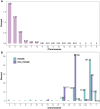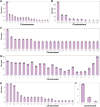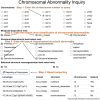A retrospective analysis of 38,652 amniotic fluid karyotype
- PMID: 40893934
- PMCID: PMC12394152
- DOI: 10.3389/fgene.2025.1655290
A retrospective analysis of 38,652 amniotic fluid karyotype
Abstract
Background: Chromosomal karyotype analysis remains a classical and frontline method in prenatal diagnosis, capable of detecting balanced chromosomal abnormalities and providing insights distinct from high-resolution molecular techniques such as CMA and CNV-Seq. However, large-scale studies on the distribution of structural abnormalities and mosaicism in amniotic fluid karyotypes are scarce, with most previous research focusing on common aneuploidies.
Objective: The study aimed to elucidate the relationship between chromosomal structural abnormalities and specific chromosomes.
Methods: We established a large-scale amniotic fluid karyotype database by collecting prenatal diagnostic indications and karyotype analysis results from amniotic fluid samples of 38,652 pregnant women who underwent prenatal diagnosis at the Beijing Obstetrics and Gynecology Hospital.
Results: From 2010 to 2024, the proportion of high-risk serological screening cases showed a decreasing trend year by year, while the proportions of high-risk non-invasive prenatal testing, increased nuchal translucency, and ultrasound abnormalities all showed increasing trends. Among all results, the proportions of non-mosaic abnormalities, mosaicism, polymorphisms, and normal karyotypes were 4.68%, 0.71%, 1.7%, and 92.91%, respectively. Inversion of chromosome 9 and variations in heterochromatin length of the Y chromosome were the most common polymorphisms. Sex chromosome aneuploidies were more prone to mosaicism. Inversions of chromosomes 9 and Y were the most frequent types of inversions. Robertsonian translocations occurred most commonly between chromosomes 13 and 14, while reciprocal translocations were most frequently observed between chromosomes 11 and 22. Chromosome breakage was most common in chromosomes Y and 1, whereas deletions were most frequently detected in chromosomes X and 5. Isochromosomes mainly appeared in a mosaic form in chromosome X. Among all indication groups, high-risk NIPT was associated with the highest positive rate for unbalanced abnormalities. A searchable karyotype database was setup, which allows users to query abnormal karyotypes identified in this study.
Conclusion: Specific chromosomal abnormalities and mosaicisms tend to occur in particular chromosomes. Therefore, attention should be paid to specific chromosomes during karyotype analysis.
Keywords: amniocentesis; chromosomal aberrations; database; karyotype analysis; prenatal diagnosis.
Copyright © 2025 Ren, Guan, Lv, Yan, Si, Yang and Yin.
Conflict of interest statement
The authors declare that the research was conducted in the absence of any commercial or financial relationships that could be construed as a potential conflict of interest.
Figures






Similar articles
-
A retrospective analysis of 6942 amniocentesis cases.BMC Pregnancy Childbirth. 2025 Aug 12;25(1):838. doi: 10.1186/s12884-025-07992-4. BMC Pregnancy Childbirth. 2025. PMID: 40797307 Free PMC article.
-
[Prenatal diagnosis and analysis of fetuses with false-positive NIPT results caused by sex chromosomal abnormalities in pregnant women].Zhonghua Yi Xue Yi Chuan Xue Za Zhi. 2025 May 10;42(5):525-531. doi: 10.3760/cma.j.cn511374-20250127-00053. Zhonghua Yi Xue Yi Chuan Xue Za Zhi. 2025. PMID: 40623922 Chinese.
-
Prescription of Controlled Substances: Benefits and Risks.2025 Jul 6. In: StatPearls [Internet]. Treasure Island (FL): StatPearls Publishing; 2025 Jan–. 2025 Jul 6. In: StatPearls [Internet]. Treasure Island (FL): StatPearls Publishing; 2025 Jan–. PMID: 30726003 Free Books & Documents.
-
Genomics-based non-invasive prenatal testing for detection of fetal chromosomal aneuploidy in pregnant women.Cochrane Database Syst Rev. 2017 Nov 10;11(11):CD011767. doi: 10.1002/14651858.CD011767.pub2. Cochrane Database Syst Rev. 2017. PMID: 29125628 Free PMC article.
-
First trimester ultrasound tests alone or in combination with first trimester serum tests for Down's syndrome screening.Cochrane Database Syst Rev. 2017 Mar 15;3(3):CD012600. doi: 10.1002/14651858.CD012600. Cochrane Database Syst Rev. 2017. PMID: 28295158 Free PMC article.
References
-
- Evans M. I., Henry G. P., Miller W. A., Bui T. H., Snidjers R. J., Wapner R. J., et al. (1999). International, collaborative assessment of 146,000 prenatal karyotypes: expected limitations if only chromosome-specific probes and fluorescent in-situ hybridization are used. Hum. Reprod. 14 (5), 1213–1216. 10.1093/humrep/14.5.1213 - DOI - PubMed
LinkOut - more resources
Full Text Sources

